I invite homeopaths here to further expand on this better since I'm not trained in homeopathy and only have a rudimentary understanding of it.
From: http://www.interhomeopathy.org/sea-remedies-a-vast-little-explored-...
Sea remedies: a vast little-explored treasure source of healing potential
“The sea is a symbol of the dynamism of life. Everything comes from the sea and everything returns to it. It is a place of birth, transformation and rebirth. With its tides, the sea symbolizes a transitory condition between shapeless potentiality and formal reality, an ambivalent situation of uncertainty, doubt, and indecision.” Phillip Robbins[1]
The sea is regarded as the source of all life; it covers about 70% of the Earth’s surface, and contains virtually all of the known elements[2]. Given its huge significance for life on the planet, only a small number of homeopathic remedies sourced from the sea are widely prescribed: Natrum muriaticum, Calcarea carbonica, Sepia, Ambra grisea and Spongia, although there are currently nearly 100 sea-sourced remedies available. The sea is the habitat of 230,000 known species; it is estimated that only 5% of the ocean has been explored, and biologists believe that over two million marine species may exist!
More than in any other realm of nature, there is a huge healing potential lying dormant in unproved sea creatures and sea plants, and in seldom prescribed sea remedies that are already available. This has led me to engage in the study of sea remedies over the last 10 years, initially through setting up ‘The Sea Remedies Project’.[3] More recently, I have taught sea remedies in a series of workshops which have included short provings[4] of new sea remedies.

SEA REMEDY THEMES
From work done by Massimo Mangialavori’[5], and my own research[6], some themes that are characteristic of sea remedies have emerged:
Sea & Water
Watery language e.g. “flow; drift; sink; swim”.
AFFINITY WITH WATER; people who need sea remedies often like to be near water or by the sea; sea hobbies; swimming, scuba diving, surfing, sailing, coastal path walking. Water seems frightening, with hidden unseen depths and threats e.g. fear of drowning, fear of sharks.
Vulnerability & Protection
VULNERABILITY: They feel VULNERABLE and have a need for PROTECTION. Fear of being injured, touched, invaded or penetrated, including sexually; need for SAFETY: “I stay inside my shell.” WITHDRAWAL from bad experiences; try to hide or escape, withdraw emotionally. Physically there may be contraction, spasms, cramps, and numbness.
Sensitivity
SENSITIVE to PAIN and SUFFERING, sensitive to mental impressions; sensitive to MUSIC; noise; odours. EMOTIONS; BEING HURT; NUMBNESS; emotional indifference; unfeeling; numbness of extremities.
Relationship Problems
ISSUES WITH BEING OPEN, INTIMATE, Sexual. LACK OF TRUST. PROBLEMS CONNECTING to other people; WITHDRAW inside themselves; difficulty with communication. Problems relating to their partner, children, close family; estrangement; feel forsaken, abandoned, misunderstood. Ailments from: loss of relationship; disappointed love. HURT and GRIEF: A tendency to dwell on negative past experiences, withdraw as a protection against further hurt or loss.
Need for Private Space
Need for PRIVACY. Prefer to be ALONE IN THEIR OWN SPACE and not be disturbed. INTRUSION. CLAUSTROPHOBIA; AGORAPHOBIA. Feelings of ISOLATION, they keep people at a distance.
Inhibition, Guilt & Shame
INHIBITED, not spontaneous. Feel unable to be themselves; restricted by feelings of guilt and RESPONSIBILITY; feel under pressure, heavy, burdened, weighed down. Ailments from reproach. Ashamed; poor self image. Need for recognition.
Food & Nurture
Relationship problems can start with MOTHER; FOOD and NOURISHMENT, eating disorders, anorexia or overeating. FOOD ALLERGIES, intolerances: salt, milk, wheat, fish and shellfish, rich food. Cravings for SALT, milk and fish.
Immaturity & Dependency
DEVELOPMENTAL PROBLEMS; emotionally and psychologically. Immaturity; reluctant to leave home; internal conflict between self-sufficiency, dependency and independency.
Gender Issues
SEXUAL AMBIGUITY; homosexuality. Reversal of male/female roles and responsibilities.
Movement
RESISTANT TO CHANGE. Anxieties about moving house. Difficulties with MOTION; stiffness; paralysis. Some remedies have to move and be active; overwork. Weakness, exhaustion, M.E from over-exertion.
BODY AFFINITIES
HORMONAL CHANGES: menopause, PMT, uterine prolapse (especially Calc carb, Sepia, Murex, Octopus)
GLANDS: all glands, particularly
THYROID and TESTES. Pain, swelling, induration, ulcers of glands (especially Calc carb, Sepia, Spongia, Nat mur, Sea Salt, Ambra grisea, Asterias, Murex)
HEART and CIRCULATION: Palpitations; fast or abnormal pulse; high or low blood pressure. Varicose veins; distension of blood vessels; sluggish circulation, heart pain. (especially Nat mur, Sea Salt, also Octopus, Cephalopods, Eel serum)
LUNGS: asthma; difficult breathing; wheezing; whistling; congestion of chest and lungs; constriction and oppression of chest. Coughs; suffocative; or dry and spasmodic; asthmatic cough. (especially Spongia Tosta, Calc carb, Sepia, Pecten jacobaeus)
WATER RETENTION; watery discharges.
DRYNESS: e.g. throat; cough; inside nose; skin. (especially Nat mur, Sea Salt, Calc carb, Spongia, Sepia, Octopus)
SKIN: Allergic skin reactions; burning, itching, stinging. Herpes; urticaria; vesicles; ulcers. Dry skin. (especially Cnidarians ~ jellyfish, urchins, coral, also Sea Salt)
CANCER: cancerous ulcers. (especially Calc carb, Sepia, Sea Salt, Ambra grisea, Asterias, Murex)
AUTOIMMUNE DISEASES: (especially Cnidarians ~ Coral, jellyfish)
 LANGUAGE COMMONLY USED IN SEA REMEDY CASES
LANGUAGE COMMONLY USED IN SEA REMEDY CASES
‘Sensation’ language is often used by patients who may need a sea remedy:
SEA: ‘at sea’, adrift, awash, ebb and flow, in the flow, seasick, salty, clear, murky, choppy, swirly, changeable, alive, wild, storm.
DEEP: depth, ‘out of my depth’, ‘hidden depths’, dark, sinking, submerged, underwater, unseen things, drowning, gasping for breath, suffocated, diving, timeless, vast space, immense.
FLOATING: ‘tossed about’, ‘like a ship at sea’, swimming, afloat, bobbing along, buoyant, balance, bubbles, light, dancing.
WAVES: ‘it comes in waves’, tides, ‘up and down’, periods, rhythm, tidal wave, tsunami, cycles, moon, full moon.
FISH: fishy, ‘wet fish’, slippery, slimy, oyster, mermaid, Neptune, crab, whale, shark, dolphin, shrimp, squid.
SHELL: protection, ‘I stay inside’, ‘my house is important to me’, ‘in my shell’, ‘soft and vulnerable inside’, ‘hard exterior’, spiral, ‘I close up’, ’half and half’ (=bivalve), ‘I build a wall’, ‘I withdraw’, ‘I hide’, ‘I close a door on it’, ‘I go into a cave’, Intrusion by drilling, breaking, intruding, crushed, smashed.
SEASIDE: seashore, beach, coast, ashore, ‘head in the sand’, shells.
DESERT ISLAND: lost, castaway, marooned, stranded, remote, detached, disconnected, estranged, distance, on an island.
WATER: flow, fluid, pressure, heavy, energy, movement, overwhelming, powerful, awesome, flood, flooding, danger, peril, engulfed, awash, cold.
GUIDELINES TO PRESCRIBING SMALLER SEA REMEDIES
Salt is the main mineral constituent of sea water (3%). As Natrum mur is a polychrest well-represented in homeopathic repertories, it is often prescribed in cases that may do better with another sea remedy.
Natrum mur, Sepia and Calc carb appearing in the top six remedies in a repertorisation, suggests looking at other sea remedies as possibilities for the case.
‘Animal kingdom’ themes or language in a case that looks like Natrum mur is a clue to consider other sea creature remedies.
If the case is Natrum mur, with sea themes, (but no animal kingdom themes or language), you could also consider Aqua marina (deep sea water), Sea Salt (from beach water), and Himalayan Crystal Salt.
Remedies made from shells, or other calcareous material of the sea creatures, often use words and phrases that suggest the mineral kingdom.
If a patient does well on one sea remedy, but the remedy action is less than hoped for, consider other remedies in the same biological group. For instance if Sepia helps to an extent but not quite enough, you could consider other cephalopod remedies: Octopus (solitary, hiding in a cave) or Nautilus (‘up and down’), or Squid (squid shoal as a social group and has propulsion, whereas Sepia is solitary and has stasis).
New sea remedy cases, provings, and materia medica information is gradually becoming more available on the internet, and in recent welcome publications by Jo Evans[7] and Rajan Sankaran[8] . However, our overall knowledge of sea remedies, like our knowledge of the sea itself, is still in its infancy, and much work remains to be done. The cases presented in this current issue of Interhomeopathy will hopefully shine a bit more light into a vast little-explored treasure source of healing potential.
References:
[1] From the proving of Aqua marina by Phillip Robbins (1999)
[2] The major elements found in the sea (in order of prevalence) are: Chlorine, Sodium, Magnesium, Sulphur, Calcium, Potassium, Bromine (also Iodine another Halogen), and Carbon. Other important elements in the sea which are indispensable to organic life include Phosphorus, Oxygen, and Nitrogen. Sodium Chloride salt comprises 3% of the total mass of sea water.
[3] ‘The Sea Remedies Project’ was set up in 2004. It involved a group of about 20 local homeopaths and homeopathy students researching lesser known and newly-proved sea remedies and then presenting them to other members of the project in bi-monthly meetings in Bristol. The project ran for about 5 years.
[4] Trituration proving of Sea Otter (Enhydra lutris). Short meditation provings of Moon Jellyfish (Aurelia aurita), Pearl (Pearl immersion), Seahorse (Hippocampus kuda), and Sea Turtle (Lepidochelys oliveacea ovum)
[5] ‘Remaining in a Safe Environment: the Sea Remedies’ – transcription of Massimo Mangialavori course by Vicky Burley.
[6] A computer repertory comparison of rubrics containing all of the sea polychrest remedies. The rubrics were placed into groups, and themes drawn out.
[7] ‘Sea Remedies: Evolution of the Senses’ by Jo Evans
[8] 'Survival: the Mollusc' by Rajan Sankaran and Sudhir Baldota
Photos:
Wikimedia Commons; Bangalley Head, Australia; Nigel Howe
Scallop shell; Jürgen Weiland
Categories: General
Keywords: sea remedies, float, drift, sink, swim, vulnerability, sensitivity, protection, privacy, relationship, inhibition, immaturity, gender, movement
http://hpathy.com/materia-medica/introduction-to-sea-remedies/
Developing a sense of the ocean and sea remedies is akin to looking into the subconscious and collective unconscious within ourselves. The author provides insights into many of the sea remedies.
Developing a sense of the ocean and sea remedies is akin to looking into the subconscious and collective unconscious within ourselves, in the present moment of our lives. The very environment of sea animal remedies–aqua marina, or sea-water, has a sense of being observed, watched, of being “looked at” or “into”, as well as a desire to “shut the doors”. As we peer into Neptunian depths, staring back at us is a continuum of the most basic—and generally subconscious–patterns of survival. As Melville wrote in the classic novel Moby Dick, . . . “it is but well to be on friendly terms with all the inmates of the place one lodges in . . .”
Looking into the sea is a metaphor for Carl Jung’s “shadow” of unresolved conflicts. “Fear of water” is seen in lyssin and the solanaceae (eg., belladonna, stramonium, hyoscyamus, etc.), where one experiences disturbing “breakthroughs” of primary instincts into waking consciousness. Universal fears relating to survival, abandonment, persecution and violence are all seen in the sea animal remedies, and in turn, understanding these remedies requires us to “step back” from those fears, and perceive from an ever-more primal stillness within ourselves, “prior to” adopting the coping strategies of the sea.


To start, it’s helpful to think about the most common elements within seawater itself:
The first element of the sea is hydrogen, with a central proving conflict between ‘earthly and otherworldly existence’—ie., ‘do I want to incarnate or not?’. A sense of betrayal, forsakenness and isolation is strong in hydrogen, and one’s ties to the earth are weak. And yet there’s also a sense of universal consciousness and connection, the feeling of oneness with the totality, which the vast ocean represents.
The next element is oxygen, and similar to hydrogen gas, it’s “ungrounded” and “unbounded”. Oxygen needs to bond with other elements during the process of “oxidation” or “respiration”, leading to “release” of stored energy from other elemental compounds. Oxygen is closely linked with “inspiring”, and is central to one of life’s most fundamental processes—the burning of fuel for energy.
A high school theater director complained of feeling scattered, distractible and hypersensitive to her environment. She’s also highly intuitive. She described how all her work was unpaid and that her husband wanted her to find a “real” job. Yet she also stated how much she enjoyed presenting ideas for plays to her students, then ‘turning them loose to work on the project’ so she could ‘feed off all that high school energy’. She responded very well to an initial dose of oxygenium 1M, and then a second dose about 6 months later.
Besides the hydrogen and oxygen of water (H20), the next element of the sea is muriaticum (chloride). As with halogens in general, muriaticum’s bonds to other elements are tenuous. The most common bond of animals is that of “mother”, and muriaticum experiences themes of mothering vs. not mothering, connection vs. disconnection, disappointment, sadness and feeling alone and separate. ‘Am I connected to motherhood? Is motherhood connected to me?’ ‘Do I connect or not?’– Sepia carries many of these same muriaticum themes.
Natrum (sodium), the next element, is very polar, and feels the longing for deep 1:1 connection, as well as emotional safety and protection. They may hide that need when relationships are perceived as emotionally unsafe. “Ailments from disappointed love” and “silent grief” are well-known characteristics of natrum muriaticum. Reflecting its generally salt-water environment, one of the main proving symptoms of salmon (oncorhynchus) was a longing for and persevering in a return to its true home.
Magnesium has been described as the “orphan remedy”, and those who benefit from magnesium can experience a sense of abandonment, and interact with others in ways to avoid “becoming an orphan”. Pleasing and peacemaking behavior results in suppression of one’s needs and identity, as well as suppression of toxic emotions at the liver.
Sulphur signifies the rudimentary development of ego strength. Self-determined, self-directed behavior is conditioned by the desire for acknowledgment and appreciation.
Calcarea (calcium) structures confer support and protection against vulnerability. Most shells in the sea are made of calcium carbonate, and turtle shells are made of calcium phosphate. Calcarea is a very important element to understand, as many of the sea’s invertebrates use some sort of variation on a shell for survival, and many of these “shell remedies” express slight variations of the main calc-c themes. To experience the role of calcium in its relation to primal protection against vulnerability, simply close the eyes while simultaneously opening the mouth–widely!
Finally, carbon takes on the tasks of life—energy is either stored up or released from bonds in carbon “chains”, in the creation of “value” and “self-worth”, and being “productive”. Expenditure of energy can also lead to depletion states.
All of the other natural elements are also found in the sea, but the more common ones above provide a general perspective of themes one may find in a sea remedy history, eg., incarnation and desire for connection, vulnerability and defense. Set against the “backdrop” of aqua marina, natrum muriaticum, spongia, calcarea carbonica and sepia provide well-known signposts for understanding the other remedies, which can be compared and contrasted with these three.
(Note: The following remedy information has been derived from Jo Evan’s excellent book “Sea Remedies: Evolution of the Senses; Massimo Mangialavori’s Sea Remedy 2002 seminar notes, and the author’s clinical experience.)
Chinese medicine describes how a person with poor “boundaries”—eg., overextending themselves, acquiescing to others, or existing in a “co-dependent relationship”– may experience problems with their lungs. In feeling one’s entire being as a sponge (porifera family), one senses its open boundaries and vulnerability—the sea’s corollary to complete dependency without a womb. The child, only recently released from the womb, experiences boundary problems through the lungs, and spongia tosta is best known for the dry cough of croup. Reflecting doctrine of signatures, the sponge is a metaphor for the ventilatory passages of the lungs: ‘I’m dependent on my environment, but there’s so much coming in to process. My life process alternates between expansion and opening and retraction and closing. I must stay in the spot where I am—there’s more than enough threat right here’. The mental and emotional state may be one of high anxiety and openness, similar to a phosphorus state (expansion)—alternating with a “shut-down” state of withdrawal (retraction).
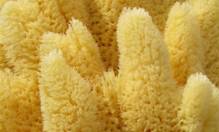
Interesting spongia tosta rubrics and sensations:
Mental symptoms aggravated by being in open air
Thoughts intrude and crowd around each other upon closing eyes
Paroxysmal anxiety in croup, heart and throat disease
Cheerfulness alternating with anxiety
Weeping, tearful mood alternating with cheerfulness, irritability, liveliness
Sadness, despondency, depression, melancholy after excessive mirth
The red coral is a close cousin to the sponge. Corallium rubrum may be thought of as a sponge that’s sharpened itself with calcium, but nevertheless experiences an inner fragility and lack of strength relative to its environment. While corallium can be verbally abusive, they can’t back that up with physical intimidation. Like coral on the reef, a diver can be cut if they happen to brush against it, but so too the coral’s often broken in the process. Like spongia, corallium is an excellent croup and spasmodic cough remedy, with the added feature of outward pressure: redness of the face, and sometimes even nose-bleeds during the cough. The coral reefs also represent the value of community in survival, and may be chosen if a person with chronic cough also seeks safety through creation of community wherever they move (see case in Jo Evans’ book Sea Remedies).
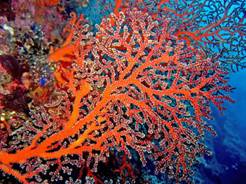
Interesting corallium rubrum rubrics and sensations:
Fear of suffering, pain
Delusion has been poisoned
Morose, sulky, cross, fretful, ill-humor, peevish
Quarrelsome, scolding with pains
Abusive, insulting with pains
Restlessness, nervousness, tossing about in sleep
The coral is taxonomically related to the anemone and jellyfish, as a member of the cnidarians (ny-DAR-ee-enz). Cnidarians rely on primitive nervous systems for survival. In most cases the anemone is tied to a sandy bottom or rock, so has developed tools for predation and survival apart from movement. Unlike coral, anemones don’t necessarily work in community, and can either repel or engulf a perceived “invader”.
Haddon’s Sea Anemone:
As mentioned above, the anemone has limited ability to move, but quickly retracts into itself when threatened. It also employs stinging poison in its tentacles for predation and defense. Proving symptoms include confusion as to personal boundaries, sensation of no defense or protection, about to be injured, sensation as if on drugs.
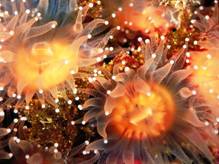
Interesting anemone rubrics and sensations:
Heightened senses; sensitive to sensual impressions, pain, rudeness
Quivering, trembling, electric shocks, internal sensitiveness
Pains: shooting, burning, stinging, itching, biting, rawness
Sadness from disappointed love
Forsaken, homesick, sentimental, self-pity
Jellyfish (medusa) also gracefully move with the currents, not actively pursuing prey, but rather creating a gentle pulsating current to draw plankton into their “mouths”. Although not engaged in active confrontation, both anemone and jellyfish employ electrochemical means for survival and defense. Medusa and anemone are essentially unstructured, and share symptoms of hypersensitivity alternating with numbness, as well as many characteristics of the better-known sepia. There’s a desire for movement, along with sensitivity to their environment and a desire to “escape” from family and friends. But where sepia is usually shut down, medusa is “alive”, even if “alive” means restless and irritable! Medusa is also known for distress at times of major transition. Mangialavori notes that clients’ gestures may also be graceful, similar to the innate graceful movement of a jellyfish in the sea.
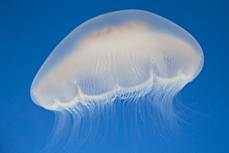
Interesting medusa rubrics and sensations:
Restlessness, nervousness; internal, tremulous
Irritability from trifles
Lashing out verbally or physically and cutting off people emotionally
Industrious, mania for work
Indifference, apathy to agreeable things
Desire for rest
Eating ameliorates mental symptoms
Aversion to change
As mentioned above, shells made from calcium provide animals with structure and protection against vulnerability. Some of the more common “shell animals” include mollusks (e.g., calc-c and sepia), echinoderms (asterias), arthropods (homarus and limulus), and reptilia (sea turtles). Each embodies a slightly different theme related to a “chosen” but confining protection as compared to freedom and mobility—and at the cost of increased vulnerability.
The best-known shell remedy—calcarea carbonica—experiences fear of being observed–that others will see into their “confusion” and vulnerability. Calc-c is impressionable and susceptible, and may include a fear of dark and their own “shadow”, e.g., the subconscious. For calc-c, the external shell of structure (home, stable occupation and income) provides safety, and there’s a desire to maintain structure for that reason. Calc-c represents the child’s or adult’s desire for stability (and even stasis) as one engages in “tasks” of life, because outside the shell exists a threatening world full of motion and change.
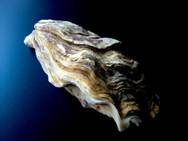
Interesting Calcarea carbonica rubrics and sensations:
Fear her condition will be observed
Impressionable, susceptible
Sensitive, oversensitive to sensual impressions
Delusions, imagines is away from home
Desires to go home
Cannot be independent
Occupation ameliorates
Along with calc-c, three other closely related remedies bear mentioning—venus mercenaria (clam), conchiolinum (mother of pearl), and mytilus edulis pearl (pearl from a mussel):
Whereas the oyster (calc-c) spends most of its life on top of the ocean floor, venus (clam) spends most of its life buried in the sand. Deep disappointment, disgust, and pessimism in life’s circumstances cause the person to distance themselves, hiding away and protecting themselves against penetration and invasion.
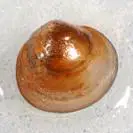
Interesting Venus mercenaria rubrics and sensations:
Delusion, imaginations that he is separated from the world
Dreams death, disease, murder, violence
Irritability in company, from noise
Ennui, boredom; Indifference, apathy
Dragging pains; lymphatic congestion; swelling of lower legs and feet
Thoughts disconnected
Conchiolinum (mother of pearl), the innermost layer of the oyster shell, is a beautiful form of calcium carbonate, and many times stronger than the middle layer, from which calc-c is derived. If calc-c is concerned that others might observe their confusion, conchiolinum has the feeling ‘How am I seen?’ Conchiolinum has had a limited proving, but is better known for its propensity towards bone and joint inflammation, as well as benign bone tumors. Conchiolinum is the “secretion” which ultimately creates the oyster pearl.

Interesting Conchiolinum rubrics and sensations:
Concern over one’s appearance
Desire to clean up one’s personal environment
Dreams of being in her own womb
Catarrh, bronchial tubes (e.g., secretion @ internal surface)
Abscesses, suppurations, joints (e.g., secretion @ internal surface)
Mytilus edulis pearl can experience the feeling of an idyllic space having been penetrated or invaded by an unwanted outsider, and the person works to wall off their thoughts or experience of the person. Pearl is known for the depth of the experience—deep, deep, deep—to the extent that a person may either feel very “connected” to someone or something, but to the extent their connection has been “sullied”, they can feel very isolated and alone.
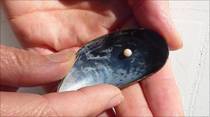
Interesting pearl rubrics and sensations:
Weepy out of proportion to cause (e.g., secretion in response to slight “invasion”)
Things are not as they were before; “out of sync”
Great sense of depth, very long-held emotions
Source of connection feels lost
Enormous pride and nobility; great purity in everything
Remedy for those who are too crystallized and inflexible
“My girlfriend and I had broken up, and then we decided to get back together. During the time apart she was in another relationship. I felt waves of tremulous emotion—anger to sadness. There were tidal waves of distress—I didn’t know my nervous system could handle this much stress. There were a lot, a lot of tears—I was weeping all day long. I felt a sense of revulsion, invasion and violation. I had these idyllic expectations, but then there was this whole other book of information to process. It was almost like being haunted by a ghost, someone in the energetic mix I didn’t invite. It’s like a Trojan horse that sneaks in, like a virus. I kept saying, ‘something smells funny’. I feel haunted, poisoned. We had a connection, a rapport, and now there’s a whole other dynamic. It’s almost like a hygiene issue—an emotional hygiene. I feel sullied. I’m obviously vastly superior to this person, our relationship had been vastly superior, but now it’s been brought down to something vulgar. There’s a consuming desire, wanting to be fulfilled, a grasping heart. I can be very self-sufficient, self-contained, okay with being alone, but I’ve been feeling very cut-off and disconnected. Through the break-up, I discovered there was this whole other depth of love, a feeling as if life isn’t long enough . . . everything up to now has been preliminary—where am I going to live, work, etc. When you’ve met those needs you can focus on your life’s work, fulfilling my potential, my destiny, doing something with my life instead of being self-centered and reactive.”
Sepia, the other well-known mollusk, has only a shell remnant, and so sacrifices a degree of safety for increased mobility with tentacles. A “conflict” exists between the shell (safety and stasis) and the tentacles (exposure and mobility). In this context we can understand the rubrics “antagonism with herself”, “contradiction of will”, and “aversion to company, yet dreads being alone”. Sepia is supported by the remnant shell structure, and yet has become “thin-skinned”, and desires to escape. The following is a helpful description for sepia:
‘ . . . The world has become too strong, too overpowering for the Sepia patient. She has been overcome by the world, and finds herself defeated. The light is too bright, the sound too loud, the children are too noisy, the husband is too rough; everything is stronger than she, and constantly attacks and overcomes her. The world has become nothing but an attack; and now she needs sepia (ink) as the cuttlefish and kraken (octopod) need it when they want to protect themselves and escape from the importunity of their enemies. Sepia darkens the waters because then the enemy can no longer see their figures; then they are as safe as their brothers the snails, who can hide in their houses, and like the mussels who breathe safely within the protection of their shell . . . ‘ (excerpt from “Sepia” by Konig, BHJ, April 1960).

Interesting sepia rubrics and sensations:
Actions are contradictory to intentions; intentions are contradictory to speech
Full of cares and worries about domestic affairs
Anger with himself and others
Wants to give up her responsibility; Cannot handle things anymore, overwhelmed by stress
Indifference, apathy to everything; to relations, family, her children
Rejects affection; aversion to sympathy
Dreams pursued, must run backwards
Nautilus is a lesser-known remedy, but will likely attract more attention in future materia medicas. An intermediate step between calc-c and sepia, this mollusk benefits from the protection of the shell even as it “motors” slowly underwater. One of the defining nautilus qualities is the ability to use more or less air in the shell to regulate buoyancy. The rubrics “ailments from upward or downward motion” as well as “ailments from loss of social position” are important characteristics of the nautilus state. The person may “temper” their moods from being too high or too low, resulting in a sort of “ennui” or apathy—neither too excited nor too depressed—and similar to the old psychological term “dysthymia”. The person who needs nautilus may hide within their shell, and at other times desire freedom. A long-time homeopath described how one of her clients benefited for years from sepia, natrum muriaticum, and aqua marina, but ultimately experienced the best results with nautilus.
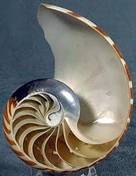
Interesting nautilus rubrics and sensations:
Delusion great person; dignified though destitute after loss of social position; desire to regain social position
Dreams boundaries, disconnection (e.g., the shell)
Dreams must jump over a fence to protect oneself (e.g., the shell)
Dreams unsuccessful efforts to go around a curve or bend in the road (e.g. the shell)
Dreams being exposed in a changing room (e.g., opening in shell)
Dreams reconnaissance, spying (e.g., nautilus eye peers out from shell opening)
Aversion to her children
“I’m just coming out of a depression. I also have problems with sinus drainage—’it’s about ready to drown me’. I worry all the time. Some thought gets in my head and goes around and around. I’m walking around like my body is a puppet. I make it move; no one knows what’s going on inside. I used to be very free and open with people. Now I’m on the inside looking out. I wouldn’t like working for someone else—I need the ups and downs. When someone is bipolar, there’s nothing more fun than when they’re up, and nothing worse when they’re down. I’m almost afraid people will find out ‘who is this shell on the outside, and who’s on the inside?’ It’s almost a physical feeling of looking out from behind my eyeballs, making my body move. I’m tired of living up to who people think I am. It feels up and down; there’s a lot of up and down in me. When I’m depressed, there’s a bubble inside me, and I know it’s going to rise. That bubble’s going to rise and I’m going to be fine—it’s my ‘mental health bubble’. I have a lack of passion, but I also don’t feel the lows people talk about.”
Murex, the sea snail, also finds protection within the structure of the shell, and yet can never completely close the opening to the outside. The loss of boundary creates exhaustion as the person seemingly can’t help but over-extend themselves—eg., excessive talking and “doing, doing, and more doing”. At other times the person may feel their space “invaded” by others’ demands—they can’t completely get away. “Exposure” to the outside world may cause innocent interactions with others to be interpreted as sexually suggestive.
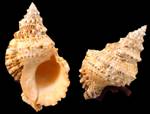
Interesting Murex rubrics and sensations:
Cannot say no
Yielding disposition
Amorous disposition
Thoughts, lasciviousness, lustful when touched
Hypochondriasis
Dreams of the sea
Asterias rubens is the red starfish, a member of the echinoderms. It moves by hundreds of tiny “feet” powered by “water hydraulics.” Pulsations of water into the feet allow for sequential motion: congestion, engorgement and “heat” alternate with relaxation, flaccidity and “coldness.” Asterias, known for a heightened libido, can also experience sexual problems—males with troublesome erections, females with decreased sexual desire. In other words, asterias experiences “hot and cold”–congested and engorged vs. relaxed and flaccid. Heightened libido alternates with diminished sexual desire and weeping. Examples of asterias symptoms of alternating pressure include: congestion of blood with sensation as if head would burst; fear of stroke; contraction/constriction in forehead as if crushed; sucked in, pressurized, trapped, under control of outside influence; and something outwardly or inwardly drawing on one’s life force.
Asterias is also a breast cancer remedy, and malignant tumors are often “fixed” to underlying structures. Tiny muscles between plates in the outer “shell” allow starfish legs to grasp firmly onto surfaces for long periods. The pressure applied in sequential motion is the same pressure employed for fixed connection. Asterias is also known for rather cold-hearted, numb and self-destructive pursuit of their goals, Other asterias symptoms include: weakness from over-activity; a feeling of offensive odor; redness, burning, inflammation, itching; breast nodules; degenerative diseases and cancer.
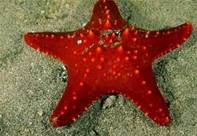
Interesting Asterias rubrics and sensations:
Anxiety with pulsation in chest
Sadness, despondency, depression, melancholy alternating with exuberance
Despair from sexual craving; weeping, tearful mood from sexual excitement
Irritability after coition
Moral affections; want of moral feeling; numb to experiencing symptoms
Delusion is away from home
Fear hearing bad news, evil, fainting, misfortune
Sensitive, oversensitive to moral impressions
Homarus, the lobster, is a member of the arthropod family. Its menacing pincers and protective shell belie its sense of vulnerability. Periodically, it sheds an outgrown shell for a new one and during this time feels this vulnerability most strongly. Hiding in the sand as the new shell thickens, homarus waits until the more overt vulnerability passes. In doing so it sheds the restriction of its former cage—it’s outgrown it—and assumes the even more “threatening” appearance of the new shell. Homarus is known for problems with milk-intolerance, as digestive juices used for the proving caused milk to curdle. If a small shell is good, a big shell is better, and homarus has been described as hiding in the shadow of an ever bigger, ever more powerful external shell—for example, relying on the support of a stronger partner, or a stronger “superhuman entity”.
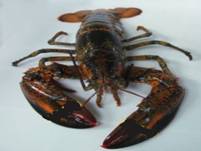
Interesting Homarus rubrics and sensations:
Polarity between angry, domineering, anarchist vs. timid, surrender
Fear of pain, laughed at., ridicule
Delusions, imaginations, he cannot move; sensation of being obstructed, immobile
Dreams handcuffed, police, tricked, crushed by a weight
Conserve their energy
Pains burning, stinging, smarting, itching needles and pins, sharp, stabbing, darting, cramping, grinding
Limulus, the horseshoe crab, is another member of the “sea arthropods”, and is recognized for its blue-colored, copper-containing blood and lymph fluid. The copper (cuprum) in limulus expresses itself with cramping symptoms, a prominent physical complaint. Cuprum tendencies also work to over-ride an inner awareness of vulnerability (i.e., without the protection of the shell) with an outer display of how “strong” they are. The copper circulating in the limulus “blood” (hemolymph) also contributes to perseverance (e.g., “pertinacity”) in tasks that might otherwise be boring. A horseshoe crab is actually not a crab at all, and is more closely related to spiders. Similarly, the restless activity of spiders is seen in limulus, and along with their persevering drive they can feel mentally and physically depleted. Whereas homarus seeks support by someone (or something) stronger, limulus tends towards the opposite—relationships with “weaker” individuals who by contrast emphasize limulus “strength”.
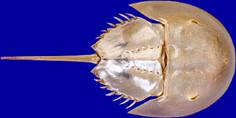
Interesting Limulus rubrics and sensations:
Pertinacity in performing irksome duties
Pressure and constriction (e.g., cramping)
Sudden, violent cough; suffocative breathing (e.g., cramping)
Sudden appearance and sudden disappearance of pains (e.g., cramping and release)
Dullness, sluggishness, difficulty of thinking and comprehending
Memory, weakness, loss of
Weakness, enervation, exhaustion, prostration, infirmity
In summary, sea remedies include themes of connection vs. disconnection, boundaries vs. vulnerability, numbness vs. sensitivity, stasis vs. motion, restrictive protection vs. freedom. One can start with the most primitive animal, the sponge, and then compare it to coral. Coral can be compared to its unstructured relatives, the anemone and jellyfish. One can move on to the oyster shell and pearl. Venus is similar to oyster but buries itself away from the world; murex can’t completely close its shell. Sepia has a shell remnant yet wants to move; nautilus’ tentacles are smaller, and it employs its shell for protection, buoyancy and ballast. The starfish runs hot and cold with “hydro-congestion and release”; the lobster and horseshoe crab counteract feelings of vulnerability through the strength of outside structures.
The homeopathic understanding of the ocean and its inhabitants is truly in its infancy. Our understanding will never be complete, but the animals above provide a starting point for perceiving the most fundamental themes of life. As one writer stated, “The ocean, though vast and mysterious, is also a place of being accepted—of being able to relax, to let go, and to flow in a place too great for the mind to imagine . . . There are the feelings of a mother—of attracting, receiving, giving birth and nurturing . . . forces which give birth to and nurture all life on our planet.”
Visit David Johnson at his website: http://www.classicalhomeopathywisconsin.com
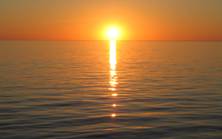
Replies to This Discussion
-
http://homeoresearch.blogspot.com/2013/05/homeopathic-proving-of-sh...
Homeopathic proving of shark liver : galeocerdo cuviere hepar (M. J. Grimes)
Galeocerdo cuvier heparThe shark is unique for a number of reasons. It has no bones; only cartilage makes up its skeleton. This also explains its place in the fossil record, as the shark appeared in our oceans at the same time as the jellyfish. Sharks never stop growing. They continue to grow teeth, ever large and larger rows. Sharks give birth to live young. This is quite a unique evolutionary adaptation to have evolved over 450 million years ago. Sharks are four times older than the dinosaurs, and one hundred times older than humans.
I chose to prove shark because I wanted to prove something parallel to us on the food chain. What makes us sick will cure us (like cures like). What could be more toxic than something which eats us? I felt that the area of sea creatures in our materia medica would benefit from being enlarged. I had heard of the medical benefits of shark cartilage, which is what I originally intended to source. After three years, I was able to obtain a homeopathic potency of shark cartilage from South Africa.
When I began the proving, I thought it would appear as a kind of "animal Nux vomica," a strong, aggressive animal energy, as the shark is portrayed in our culture. Instead, there were dreams of taking care of children, dreams of mothers and grandmothers, and of belonging to groups. For an animal that lives its life alone, this was surprising.
Our current Western perception of the shark as an aggressive creature stems from 15th century Europe, the time when the shark first made its way, as a curiosity, aboard a returning explorer's vessel.
In the Pacific, among peoples familiar with the shark, a different sensibility had arisen. There were tales of sharks saving people from drowning. In Hawaii, it is thought that sharks are the keepers of the souls of ancestors, that people give birth to sharks, and that sharks give birth to people. The idea of shark as a man-eater was not found in cultures that were familiar with the shark. It is only in Europe, at a time that witches were being burned at the stake, that the shark, with its strong female power, became something to fear. The proving produced a lot of itch and a very distinct left-sidedness. Interestingly enough,there were a lot of food cravings but absolutely no aversions. This shark is known as the garbage can of the sea. This is a list of things that have been found in a shark's stomach, this tiger shark: nuts, bolts, tin cans, boat cushions, driftwood , alarm clocks, bricks, bottles, beer cans, watches, license plates, overcoats, belts, shoes, tree trunk, rats, dogs, sheep, turtles, which they are fond of, sharks like turtles, crocodile heads, conk, lobsters, wallets, other sharks. After eating a shark does not eat for days. They do not digest food in their stomach it is a storage place. Food, when they are hungry is moved to their intestine.
Remedies from the sea
Sea creatures seem to have a special affinity with the reproductive system. Sepia seems to be for the stage of life of childbearing or just after. Onchorynchus, Salmon is for adolescence. Galeocerdo, Shark, seems to be a menopausal remedy, an old crone.
Other remedies from the sea include: Sepia (Cuttlefish); Onchorynchus (Salmon); Ambra grisia (Whale ambergris); Serum angulara (Ichthyotoxinum, Eel serum); Asteria (Starfish); Limulus (King crab); Lac del-phinum (Dophin milk); Fucus vesiculosus (Kelp); Murex (Purple fish); Oleum morrhua, (Cod liver oil, which also has restored menses); Spongia (toasted Sea sponge); Homarus, (Lobster); Castoreum (Beaver); Corallium rubrum (Red coral); Conchiolinum (Mother-of-pearl); Gadus morrhua (Cod fish); Venus mercenaria (American scallop).
Liver
Shark liver has been used for centuries in healing. The liver comprises 80%, of a shark's abdominal cavity. Recently, much research has been done on shark cartilage and cancer. The use of sharks and shark liver oil for health benefits is not new, but has been widely practiced throughout the world.
Medical claims for shark liver oil include:
• Lowers LDL-Cholesterol and blood triglycerides and raises HDL-Cholesterol
• Decreases platelet aggregation, thus inhibiting blood clot formation
• Contributes in lowering blood pressure (hypertension) by promoting vasodilatation
• Useful in arthritis because of anti-inflammatory effects
• Beneficial in treating psoriasis and skin problems
• Contributes or elasticity of arterial walls
• Maintains healthy mucous membranes, healthy skin, and reduces build up of plaque
• As an aid to asthma sufferers.
Squalene
Unsaturated terpenic hydrocarbon (C30H50) is a major component in shark liver oil. Squalene is an essential part of the human body. i A small amount is distributed throughout the whole body in the form of sebum, of which 12% is composed of squalene. Squalene can also be found in plant oils.
Experiments have shown that squaline inhibits the formation of new blood vessels induced by a type of brain tumor known as a glioma. Other research has determined that squalene works by changing a cell's shape through disrupting the exchange of sodium and hydrogen on its surface.
Gulf war
Around 100,000 American soldiers who served in the 1991 Gulf War developed a mysterious illness involving memory loss, thyroid disorders, allergies, fatigue, rashes and persistent pain.
Squalene is accused of being the leading cause of Gulf War Syndrome (GWS). Although the government has not admitted it, American soldiers received experimental vaccines for AIDS and hepatitis which contained a synthetic form of squalene which was not approved by the FDA. All of those suffering GWS symptoms have tested positive to the squalene antibody. A government source is quoted as saying: "I can't tell you why it's there, but there it is. And I can tell you this, too: The sicker an individual, the higher the level of antibodies for this [squalene] stuff. I'm not telling you that squalene is making these people sick, but I am telling you that the sick ones have it in them."
Miasm
Based on the amount of itch, I think this remedy is part of the Psoric miasm. There was also a sense of urgency and immediacy-quick to anger, time passing too slowly-that makes me think it might be in the Acute miasm, near Stramonium or Belladonna. I repertorized 35 rubrics from sensations in the proving and the first ten remedies that came up were minerals, with Natrum muriaticum being first. (One might expect Sulphur to appear first in any repertorization of 35 remedies, but that was not the case with this exercise.)
Itch
The remedy had itches in almost every part of the body. Provers experienced itches in the following body parts:
Eyes
Head
Mouth
Trunk
Female genitalia
Legs
Arms
Knee
Skin
Cured symptoms
Symptoms that were cured in the proving were:
• Fibromyalgia
• Chronic constipation
• Hot flashes.
• Sharp pains
In the provers' own words, sharp pains were experienced in the following parts of the body:
• Joints painful, pains were pointed.
• Sudden sharp shooting pain, left shoulder, moving toward arm.
• Right elbow pain, sharp. Sensation is in one small spot.
• Sharp pain on top of head, slightly to the left, lasting only about one second.
• Sharp pain behind right breast, to inside of body.
• Continuing sharp stinging, at point on left back, below scapula, left shoulder.
• Sharp needle-like pain in left back.
General, mental, and SRP symptoms:
• Pain in small spots.
• Periodicity at 5 a.m. and 5 p.m.
• No food aversions and a large list of food cravings.
• Time passed too quickly; or time passed too slowly.
• Exercise ameliorates:
"Back pain is resolved even after carrying old, heavy, backpack all day."
"Lower back pain returned. Biked a lot and enjoyed that."
• Mind somewhat dull. Not sharp.
• Stools with tails.
Hum
"Still have some of the humming I had at start of proving. The pitch feels like it's a high pitched hum, more on the right side. It feels like my whole body is humming and it feels like a real clear distinction between where my body is and where the chair is."
Body sensation
"The feeling of my body tingling removed from itself, outside itself, beside itself was intense, subtle. On several occasions I would try to describe the sensation to others but met great difficulty. I felt different extended, solid but unstable this alternated with feeling my bones my structure quiet firmly."
Sidedness
The remedy produced distinct sidedness on both left and right, with the left being stronger.
Left-sided symptoms were produced in:
Back
Head
Throat
Wrist
Neck
Eye
Mouth
Knee
Arm
Groin
Right-sided symptom appeared on:
Head
Knee
Eyes
Arm
Shoulder
Breast
Black fear
"Fear of the dark on driving home tonight. Unusual as I am not afraid of the dark. Couldn't get out of the car to close the gate, from fear. Troubled feeling. Locked my car door on the way home. Very unusual. Very odd."
Tiger shark as mother of the sea
"Vision of a dark haired woman with dripping black teeth. Smiling black dripping teeth. The dark woman with the dripping grin is the dark side of myself. I need to pray a lot to keep her out of my mind. She hovers around, then I pray and she disappears for a while. The dark side of the soul. Can't get the woman's picture-her smiling black dripping teeth-out of my head..."
From the proving
Kali is the Hindu triple Goddess of creation, preservation, and destruction, known as the "Dark Mother." It appears that the prover was seeing some form of this image.
It is said about Kali she that devours all existence. She chews all things existing with her fierce teeth. Therefore a mass of blood is imagined to be the apparel of the Queen of the Gods at the final dissolution.
Kali is pictured as the basic archetypical image of the Death Crone, the birth-and-death mother, the giver of life and devourer of her children.
It is interesting that this fiercely feared female image appeared to a prover. This is similar to the fear our culture has of the shark.
We can only speculate on what this prover's vision means and how this is connected to the healing power of this medicine, but I include this information for the reader to ponder.
Dream themes
• Women-widows, single
• Mothers-like looking for birth mother
• Children, taking care of
• Groups of people, community, gatherings (Connections)
• Schools
• Homes, houses, rooms
• Rods, fence posts, bars, fingers
• Machines, bicycles, chain saws, backhoe
• Movement, walking, biking, basketball
• Travel
• Pride/Embarrassment
• Sex and sexual ambiguity
• Guilt, doing wrong, unprepared
• Performance
• Food
• Sacred, drums, church
• White, snow, light
• Power/food chain/control
• Cold
• Frustration
• Belonging, fitting in, lonely (Disconnection)
• Judgment, tests, criticism
• Responsibility
• Danger
"I think about hammering on an oriental woman's fingers. The feeling is similar to that of Chinese foot bindings. She was a friend. I had to hammer her fingers hard enough to break them on first blow (into position). If I did it right, hard enough, it would be less hard for her to endure the loss of her fingers. She had to go through it. There was the hardness required to crush them completely so she didn't have to go through the torture of having them continually rebroken. If I did it hard the first time they would be ruined immediately so I wouldn't have to do it over and over again.
You hammer their fingers from bottom up if you want them to break.
The feeling was that if the fingers are hammered correctly, it just makes it easier for the woman. No question of the act. No exceptions, valid. No feelings of remorse.
The thought was that I could take great pride out of being able to do it right-to crush the bones so thoroughly with the hammer. It was powerful. There was no doubt it had to be done, and I knew how to do it with the right angle. There was an internal drive to hammer, to smash the finger. If I could do it right I felt I was doing my job. I was superior at what I was trying to do. Somehow I felt I was servicing her by doing it right. Female oppression issue again."
"I was doing some woodworking in our basement using the bench saw when the saw blade, which was about half the diameter of the usual 10" blade, escaped from the saw and started up the cement wall. I needed to control it and started to chase it. Then I realize I just needed to shut off the power to the saw, so I did. Then the same thing happened when my husband was down in the cellar and I just shut off the power again to stop it. We both agreed it wasn't a great idea to let the blade get out of control like that. The feeling at first was that I let something get out of control and had to control it, but there was also a sense of intrigue and amusement that this could happen. For the most part it was an enjoyable and entertaining dream."
Strange rare and peculiar
Rats: "Had the idea, and have had this idea twice in the last few days, that my thoughts could penetrate the wall and influence the rats or the mice-to make them be quiet or make them die." Ocean: "I feel I am in the middle of an ocean, not knowing what direction to swim in. It is the same distance to any shore. And they all seem far away. It makes most sense to flow and see what direction I go naturally. But there are some doubts that I should exert some effort in some direction. I just want to lie still and let the sun fill me with warmth and light. But then the night comes; it's cold and lonely. I want to be somewhere other than where I am. This sensation was very clear, very definite. I remember it clearly. It happened three times." Pain better for movement: "Back pain is resolved even after carrying old heavy back-pack all day. I feel more solid, matter of fact in body. I feel my bone structure more firmly." Hum: "The feeling of my body tingling, removed from itself, outside itself, beside itself was intense, subtle. On several occasions I would try to describe the sensation to others but met great difficulty. I felt different -extended, solid but unstable. This alternated with feeling my bones, my structure quite firmly.
"Still have some of the humming I had at start of proving. The pitch feels like it's a high pitched hum, more on the right side. It feels like my whole body is humming and it feels like a real clear distinction between where my body is and where the chair is. A feeling of fullness in the body. And in that sense, there is a feeling of being beside my body. More aware of the perimeters of my body than outside of it. Like I can be objective about the edges of my body. You're actually aware that you're present. Not a density but more of a different presence."
About the proving
This proving was double-blind and full-Hahnemannian. None of the provers met each other, not did any of them or the supervisors ever meet me. This created an unusual, double- blind experience. I believe that in situations where provings are conducted within a group, there is a kind of contagion. Certain symptoms symptomatic of the group are intensified. Provers and supervisors were not aware of the remedy source. Only five people in the world knew that this substance was being proven. Even the pharmacies did not know, because the potentizing of the substance was done in South Africa, by the homeopath who sourced it. Provers and their supervisors each kept daily notebooks. The proving began in November 1997.
-
-
It was mentioned in this site: "Take note that remedies such as Stramonium, Aconite, Opium, and Hydrogen, deal with those that have been shaken from their foundation. They have been up rooted by a trauma or some type of fright."
Hydrogen - http://www.tinussmits.com/3875/hydrogenium.aspx
Essence of Hydrogenium
The down to earth picture
Maybe the best description of the Hydrogenium state is the Paradise Lost state. In the astral world we are connected with everything, united with the whole and simply part of the whole. Then we are stepping out of this harmony and incarnating in the physical world, where duality is the rule and where we lose the consciousness that we are all One and connected with each other. The little baby can still partly be in this state of connection, but rather quickly he will get the paradise lost feeling. The challenge in this earthy life is not to stay in the consciousness of the Whole, but to accept fully the physical and material experience as part of the game. The ultimate purpose is to become conscious what oneness really is. To understand this profoundly I refer to the books of Neale Donald Walsch, Conversation with God, tome 1, 2 and 3 and all his later books. To become conscious of LOVE we have to experience NON-LOVE, to become conscious of the LIGHT we have to experience DARKNESS, because only the experience of darkness can give us the conscience of what is Light. This is also true for ONENESS. To become consciousness of what is Oneness we have to experience Non-Oneness, what is Separation or Duality. So the real Hydrogenium state is not the state feeling ONE with everything, but the experience of separation with the desire to experience again the Oneness, first with our Soul and then with all the other Souls and so with the Universal Soul. But the process goes necessarily through the experience and acceptation of our incarnation in this material world. Wanting to avoid this experience by trying to stay in the Oneness is refusing the experience to become conscious. It is like wanting to dry you body with a towel before you have taken the bath. For me Hydrogenium is not a birth state remedy, but the state of a soul that has gone through the challenges of fully incarnation (Lac maternum), experience of ego (as separated from the whole) (Carcinosinum/Cuprum) and of the state of non-love (Saccharum), has played the fight of friend and enemy, defeat, victimization, oppression and victory (Rhus-tox. and Anacardium) and who has a strong desire after having experienced and resolved all these experiences of separation to connect again to the Oneness with full Consciousness. Then Hydrogenium has to be given as a last remedy after all the others and is in some way the crown on the work for the courage we had to live our life and to become conscious. Hydrogenium will not take us out of the reality of this physical world but make us more conscious of the connection with our own soul and with the whole as in the above case. So to say there is a logical sequence respecting the game of the cosmos. In this consciousness the physical world in which we live here on earth is equally part of the cosmos as is the astral world. There is no exclusion only inclusion. I have to emphasize here that being healed by Hydrogenium doesn’t mean that we constantly experience the oneness, surely not. As long as we live in this physical body we will experience duality and the exalted Hydrogenium state is not the state we should look for. It is a state of misbalance in which we are not longer capable to live our life harmoniously; we become psychotic and inapt at this life.
The exalted picture
There is another Hydrogenium state which is caused by the refusal to accept the experience of this material world and to try by all means to get out of the material world and to connect with the One again as quick as possible. Then physical life is a burden and has to be avoided as much as possible. No sex, no pleasure of the table, no beautiful clothes, no possessions, no sin, just meditation as a way to join the One as soon as possible. I am not criticizing this way of life; as human beings with a clouded consciousness we cannot completely go to the bottom of the mystery of life. And every experience in this world whatever it is, serves the Whole in growth of consciousness. So every way of life deserves respect, even if we think we should never make that choice, which is probably a delusion. But focus mainly on the non-physical state, even without refusing the physical experience, can create also a Hydrogenium state in which we lose control over the physical reality. In these cases Hydrogenium will also restore the balance between physical and non physical life and not promote just one. The first case I ever heard was on the Professional Case Conference 1994 in Seattle, USA, organized by the IFH. Steve Olsen, ND from Canada, presented a very interesting case of paranoid schizophrenia. The description of this case is as follows: “This 45 year old man spends many hours, weeks and months in meditation, reading esoteric literature and thinking about how to make positive and creative solutions in his life and the lives of others. Then there is a breakthrough, his mind makes a connection with the supreme life force. Here he finds eternal truths, revelations and excitements about the possibilities before him. (…)” Steve’s comments: “Along the path to complete his mission something goes wrong, there are distortions in perception, the information does not integrate into the real world; the ego gets too inflated and past conflicts that are not resolved come to the surface. Ultimately the state of higher consciousness becomes too much to handle.“ Steve makes some interesting remarks concerning this case: “This is an experience perhaps that many people are trying to achieve; i.e. that of transcendence from the physical boundaries and into the mystical spiritual realms. (…) In this case I believe the desire to develop the capacity to unite with the “source of all things” was premature and led to a certain type of imbalance, distortion and breakdown. As one author puts it: “The road to enlightenment is littered with the wrecks of souls that were not ready for the powerful forces that are generated from such action. This is a diseased state because he no longer had any choice over his thoughts and actions.”[1] Hydrogenium 200K brought him back to earth and he recovered nicely. I had a similar case of maniacal psychosis which occurred also after long and intensive meditation. He could be saved from the psychiatric hospital with Hydrogenium 30K. The patient recovered completely, but was on the edge of the abyss. -
-
AQUA MARINA PROVING
INTRODUCTION
‘In addition to it’s major chemical constituents (sodium, chlorine, magnesium, sulphur, calcium, potassium, bromine, carbon, strontium, boron, silicium, and fluoride), seawater also contains trace amounts of all the other elements of the periodic table. The minute traces of inorganic and organic nutrients are essential for the growth of phytoplankton, on which all life in the oceans depend1’ In fact the sea water can be considered the life blood of ‘Gaia’ the living earth. Without water there is no life, so water in general is a symbol of life.
Sea water has a rich use as symbol in many traditions. It has been used to represent formless potential and the unconscious, emptiness, enlightenment and divine being, the giver and taker of life, the dynamism of life and the human heart and passions. These themes are all bigger than or beyond the individual and relate to the spiritual understanding of connectedness with everything.
In Ancient Egyptian mythology, the coming into being of Earth and life was conceived in terms of emergence from the ocean, just as mudbanks emerged from the falling floodwaters of the Nile. Thus creation for the Egyptians, including even that of the gods themselves, arose from the primeval waters of the ocean.2
Because of their apparent limitless extent, oceans are images of the undifferentiated state of primeval formlessness or potential. In Mahayana Buddhism the ocean is ‘Dharma-kaya’, the Enlightened Body of the Buddha which mingles with ‘Bodhi’, the primeval intellect. Its calm surface symbolises both emptiness and enlightenment. Seas are also symbols of Divine Being, of Nivana and of Tao. The Tao Te Ching speaks of the Tao being to the world what the sea is to rivers. ‘All waters flow into it without filling it; all waters flow from it without draining it. This is why I go to the sea.’ (Chuang Tzu ch 12). In Tantrism, the ocean is the Universal Spirit, ‘Paramatma’, into which is mingled the drop of the water of life, ‘jiva’, or ‘jivatma’, the individual soul. 2
The ancient Greeks and Romans offered horses and bulls, themselves symbols of fertility, in sacrifice to the sea. But monsters rise from the depths, and so the sea is also an image of the unconscious which has currents of its own which may be either lethal or regenerative.2 The sea partakes of the divine property of giving and taking life.
The Christian mystics were some who took the sea as a symbol of the human heart as the seat of the passions. When the sea is stormy, to reach the further shore entails a dangerous crossing of its treacherous water - the sea of passions.
In summary sea symbolism is linked with that of water in the context of the origin of all life. The sea is a symbol of the dynamism of life. Everything comes from the sea and everything returns to it. It is a place of birth, transformation and rebirth. With it’s tides, the sea symbolizes a transitory condition between shapeless potentiality and formal reality, an ambivalent situation of uncertainty, doubt and indecision which can end well or ill. Hence the sea is an image simultaneously of death and of life.
-
-
Thank you Carl, great share
-
© 2025 Created by Tara.
Powered by
![]()